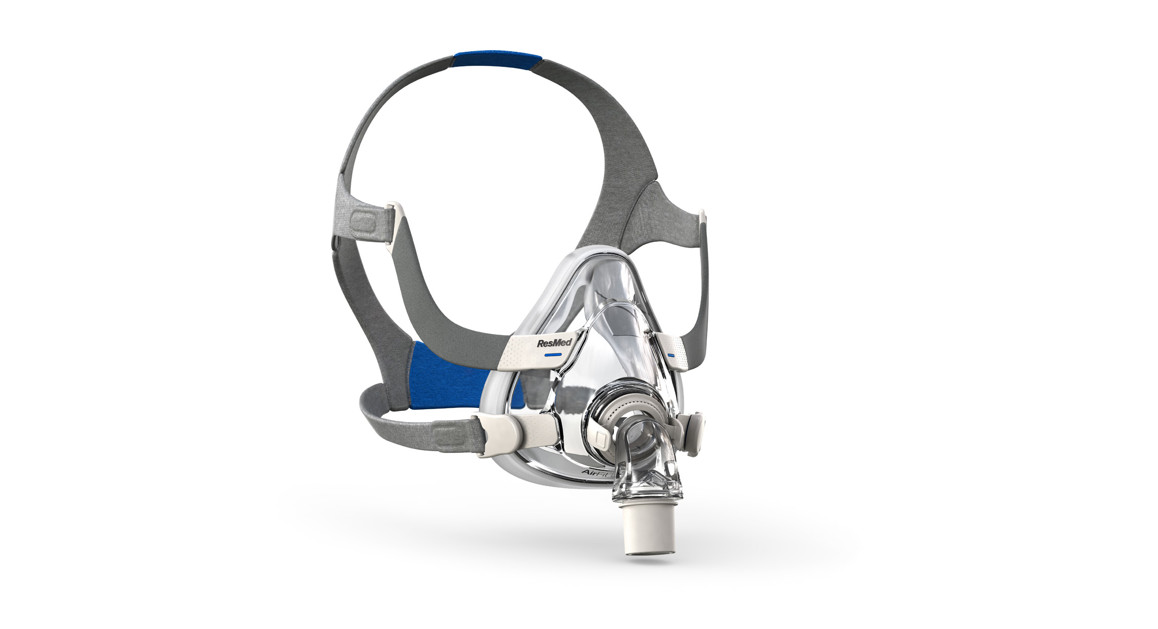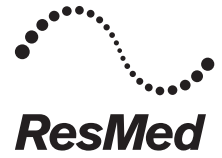

User guide
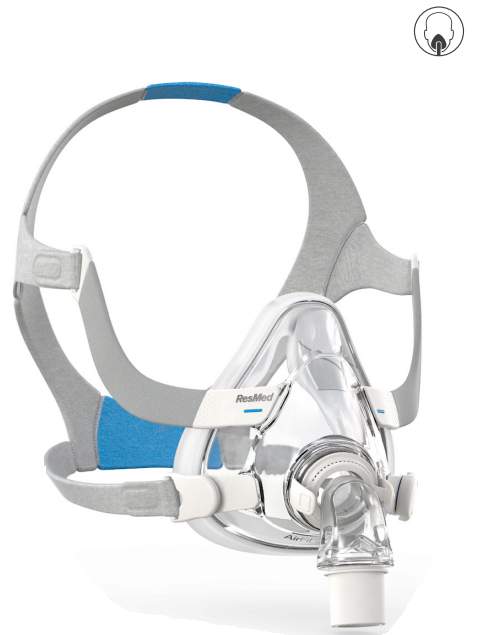
Fitting

Adjustment
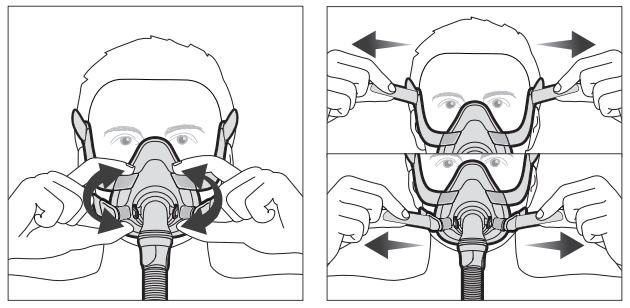
Removal
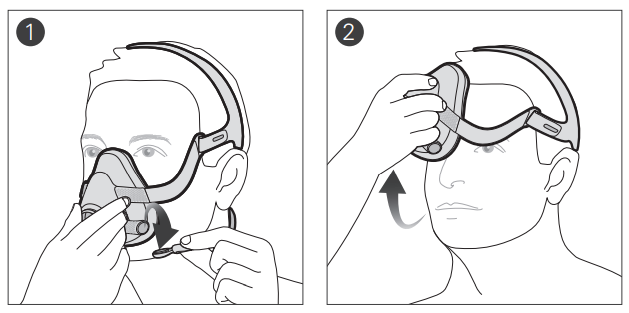
Disassembly
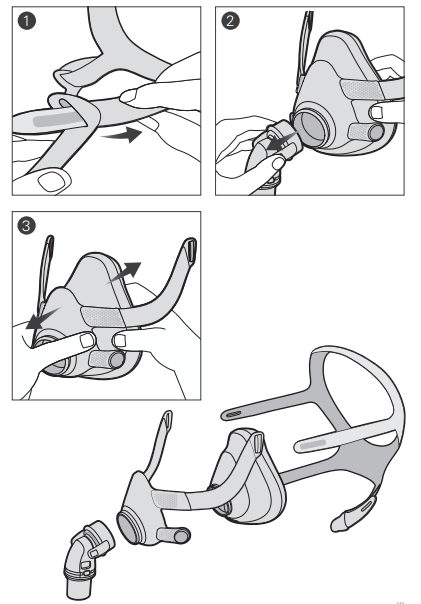
Reassembly
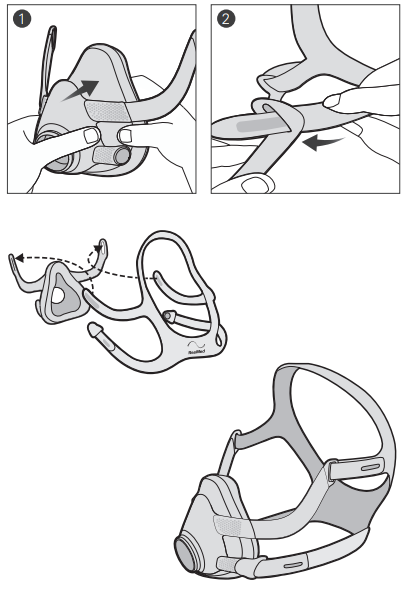
Cleaning the vent
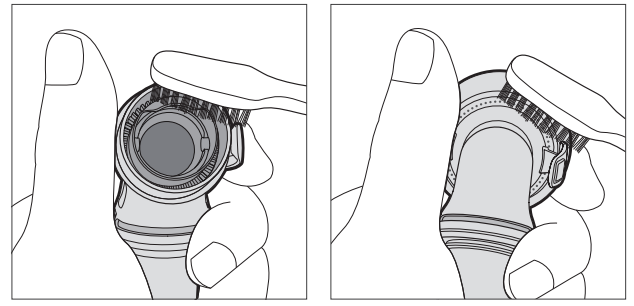
Full face maskThank you for choosing the AirFit F20. This document provides the user instructions for the AirFit F20 and AirFit F20 for Her masks referred to collectively as AirFit F20 throughout this manual.
Using this guidePlease read the entire guide before use. When following instructions, refer to the images at the front of the guide.
Intended useThe AirFit F20 is a non-invasive accessory used for channeling airflow (with or without supplemental oxygen) to a patient from positive airway pressure (PAP) device such as a continuous positive airway pressure (CPAP) or bilevel system.
The AirFit F20 is:
- to be used by patients weighing more than 66 lb (30 kg) for whom positive airway pressure therapy has been prescribed
- intended for single-patient reuse in the home environment and multi-patient reuse in the hospital/institutional environment.
![]() WARNINGMagnets are used in the lower headgear straps and the frame of their fit F20. Ensure the headgear and frame is kept at least 2″ (50 mmaway from any active medical implant (eg, pacemaker or defibrillator) to avoid possible effects from localized magnetic field strength is less than 400 mT.
WARNINGMagnets are used in the lower headgear straps and the frame of their fit F20. Ensure the headgear and frame is kept at least 2″ (50 mmaway from any active medical implant (eg, pacemaker or defibrillator) to avoid possible effects from localized magnetic field strength is less than 400 mT.
ContraindicationsThe use of masks with magnetic components is contraindicated in patients with the following pre-existing conditions:
- a metallic hemostatic clip implanted in your head to repair an aneurysm
- metallic splinters in one or both eyes following a penetrating eye injury.
![]()
![]()
![]()
- The mask must be used under qualified supervision for users who are unable to remove the mask by themselves. The mask may not be suitable for those predisposed to aspiration.
- The mask must be fitted with the supplied elbow (containing the valve and vent assembly) to ensure safe and functional usage unless otherwise specified. Do not use the mask if the valve or vent assembly is damaged or missing.
- The elbow, valve and vent assembly have specific safety functions. The mask should not be worn if the valve is damaged as it will not be able to perform its safety function. The elbow should be replaced if the valve is damaged, distorted or torn. The vent holes and valve should be kept clear.
- The mask should only be used with CPAP or bilevel devices recommended by a physician or respiratory therapist.
- Avoid connecting flexible PVC products (eg, PVC tubing) directly to any part of the mask. Flexible PVC contains elements that can be damaging to the materials of the mask and may cause the components to crack or break.
- The mask should not be used unless the device is turned on. Once the mask is fitted, ensure the device is blowing air. Explanation: CPAP and bilevel devices are intended to be used with special masks (or connectors) which have venting to allow a continuous flow of air out of the mask. When the device is turnedon and functioning properly, new air from the device flushes the exhaled air out through the mask holes. When the device is turned off, the mask valve opens to the atmosphere allowing fresh air to be breathed. However, a higher level of exhaled air may be rebreathed when the device is off. This applies to most full-face masks for use with CPAP and bilevel devices.
- Follow all precautions when using supplemental oxygen.
- Oxygen flow must be turned off when the CPAP or bilevel device is not operating so that unused oxygen does not accumulate within the device enclosure and create a risk of fire.
- Oxygen supports combustion. Oxygen must not be used while smoking or in the presence of an open flame. Only use oxygen in well-ventilated rooms.
- At a fixed rate of supplemental oxygen flow, the inhaled oxygen concentration varies, depending on the pressure settings, patient breathing pattern, mask, point of application, and leak rate. This warning applies to most types of CPAP or bilevel devices.
- The technical specifications of the mask are provided for your clinician to check that they are compatible with the CPAP or bilevel device. If used outside specification or if used with incompatible devices, the seal and comfort of the mask may not be effective, optimum therapy may not be achieved, and leak, orvariation in the rate of the leak may affect the CPAP or bilevel device function.
- Discontinue using this mask if you have ANY adverse reaction to the use of the mask, and consult your physician or sleep therapist.
- Using a mask may cause tooth, gum, or jaw soreness or aggravate an existing dental condition. If symptoms occur, consult your physician or dentist.
- The F20 line of full-face CPAP masks is not intended to be used simultaneously with nebulizer medications that are in the air path of the mask/tube.
- As with all masks, some rebreathing may occur at low CPAP pressures.
- Refer to your CPAP or bilevel device manual for details on settings and operational information.
- Remove all packaging before using the mask.
Using your maskWhen using your mask with ResMed CPAP or bilevel devices that have mask setting options, refer to the Technical specifications section in this user guide for the correct setting.For a full list of compatible devices for this mask, see the Mask/Device Compatibility List on www.resmed.com/downloads/masks. If you do not have internet access, please contact your ResMed representative.Use a standard conical connector if pressure readings and/or supplemental oxygen is required.
Fitting
- Twist and pull both magnetic clips away from the frame.
- Ensure that the ResMed logo on the headgear is facing outwards and is upright. With both lower headgear straps released, hold the mask against your face and pull the headgear over your head.
- Bring the lower straps below your ears, and attach the magnetic clip to the frame.
- Undo the fastening tabs on the upper headgear straps. Pull the straps evenly until the mask is stable and positioned as shown in the illustration. Reattach the fastening tabs.
- Undo the fastening tabs on the lower headgear straps. Pull the straps evenly until the mask is stable and sits comfortably on the chin.Reattach the fastening tabs.
- Connect the device air tubing to the elbow. Attach the elbow to the mask by pressing the side buttons and pushing the elbow into the mask, ensuring it clicks in on both sides.
- Your mask and headgear should be positioned as shown in the illustration.
AdjustmentIf necessary, slightly adjust the position of the mask for the most comfortable fit. Ensure that the cushion is not creased and the headgear is not twisted.
- Turn on your device so that it is blowing air.Adjustment tips:With air pressure applied, pull the mask away from your face to allow the cushion to inflate and reposition onto your face.• To resolve any leaks at the upper part of the mask, adjust the upper headgear straps. For the lower part, adjust the lower headgear straps.
- Adjust only enough for a comfortable seal. Do not overtighten as this may cause discomfort.Removal1. Twist and pull both magnetic clips away from the frame.2. Pull the mask away from your face and back over your head.
CAUTIONVisible criteria for product inspection: If any visible deterioration of a system component is apparent (cracking, discoloration, tears etc.), the component should be discarded and replaced.
Daily/After each use:
- Disassemble the mask according to the disassembly instructions.
- Rinse the frame, elbow, and cushion under running water. Clean with a soft brush until the dirt is removed.
- Soak the components in warm water with a mild liquid detergent for up to ten minutes.
- Shake the components in the water.
- Brush the moving parts of the elbow and around the vent holes.
- Brush the areas of the frame where the arms connect, and inside and outside the frame where the elbow connects.
- Rinse the components under running water.
- Leave the components to air dry out of direct sunlight. Make sure to squeeze the arms of the frame to ensure that excess water is removed.
Weekly:
- Disassemble the mask. The magnets can remain attached to the
- Handwash the headgear in warm water with mild liquid detergent.
- Rinse the headgear under running water. Inspect to ensure the headgear is clean and detergent-free. Wash and rinse again, if necessary.
- Squeeze the headgear to remove excess water.
- Leave the headgear to air dry out of direct sunlight.
Reprocessing the mask between patients
Only Sleep Lab Mask (SLM) variants of the mask are intended for multi-patient re-use. When using between patients, these masks must be reprocessed accordingto cleaning and disinfection instructions available on ResMed.com/downloads/masks.
Troubleshooting
| Problem/possible cause | Solution |
| Mask is uncomfortable. Headgear straps are too tight. | The cushion membrane is designed to inflate against your face to provide a comfortable seal with low headgear tension. Adjust straps evenly. Ensure that the headgear straps are not too tight and that the cushion is not creased. |
| Mask could be the wrong size. | Talk to your clinician to have your face size checked against AirFit F20 fitting template.Note that sizing across different masks is not always the same. |
| Mask is too noisy. Elbow incorrectly installed or incorrect assembly of the mask system. | Remove the elbow from your mask, then reassemble according to the instructions.Check that the mask is correctly assembled according to the instructions. |
| Vent is dirty. | Use a soft bristle brush to clean the vent. |
| Mask leaks around the face. Cushion membrane is creased. Mask is incorrectly positioned or adjusted. | Refit your mask according to the instructions.Ensure that you position the cushion correctly on your face before pulling headgear over your head. Do not slide the mask down your face during fitting as this may lead to creasing of the cushion. |
| Mask could be the wrong size. | Talk to your clinician to have your face size checked against the fitting template.Note that sizing across different masks is not always the same. |
Technical specifications
| Pressure-flow curve | The mask contains passive venting to protect against rebreathing. As a result of manufacturing variations, the vent flow rate may vary. | |
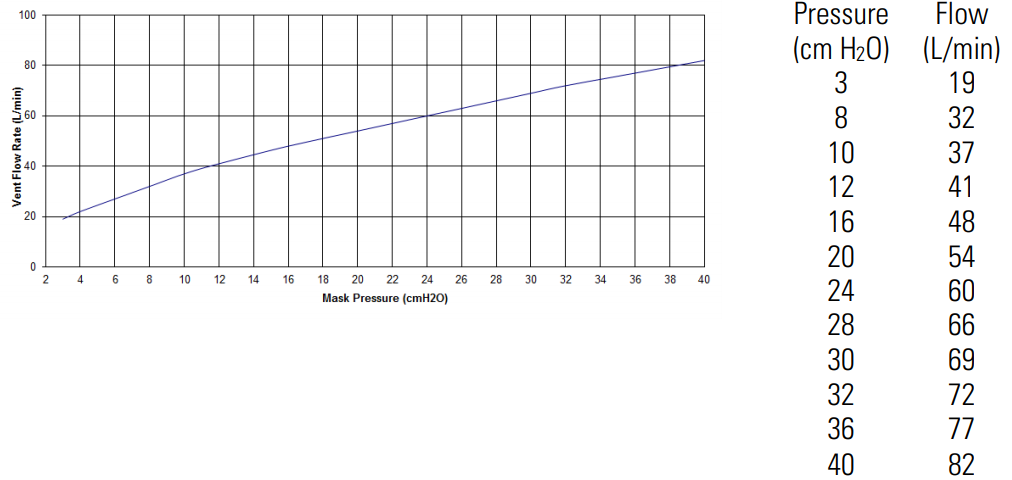  |
||
| Dead space information | Physical dead space is the empty volume of the mask to the end of the swivel. Using the large cushions it is 240 mL. | |
| Therapy pressure | 3 to 40 cm H2O | |
| Resistance withAnti Asphyxia Valve(AAV) closed to atmosphere | Drop-in pressure measured (nominal)at 50 L/min: 0.2 cm H2Oat 100 L/min: 0.6 cm H2O | |
| atmosphereInspiratory and expiratory resistance with AntiAsphyxia Valve (AAV) open to atmosphere |
Inspiration at 50 L/min:Expiration at 50 L/min: |
0.6 cm H2O0.7 cm H2O |
| Anti Asphyxia Valve(AAV) open-atmosphere pressure | ≤3 cm H2O | |
| Anti Asphyxia Valve(AAV) closed-to atmosphere pressure | ≤3 cm H2O | |
| Environmental conditions | Operating temperature: 41°F to 104°F (5°C to 40°C)Operating humidity: 15% to 95% non-condensingStorage and transport temperature: -4°F to 140°F (-20°C to +60°C)Storage and transport humidity: up to 95% non-condensing | |
| Sound | DECLARED DUAL-NUMBER NOISE EMISSION VALUES in accordance with ISO 4871. The A-weighted sound power level of the mask is 30 dBA, with an uncertainty of 3 dBA. The A-weighted sound pressure level of the mask at a distance of 1 m is 23 dBA, with an uncertainty of 3 dBA. | |
| Gross dimensions | Mask fully assembled with elbow assembly (no headgear)6.1″ (H) x 6.3″ (W) x 5.8″ (D)(154 mm (H) x 159 mm (W) x 147 mm (D)) | |
| InternationalCommission onNon-IonizingRadiationProtection (ICNIRP) | Magnets used in this mask are within ICNIRP guidelines for general public use. | |
| Service life | The service life of the AirFit F20 mask system is dependent on the intensity of usage, maintenance, and environmental conditions to which the mask is used or stored. As this mask system and its components are modular in nature, it is recommended that the user maintain and inspect it on a regular basis, and replace the mask system or any components if deemed necessary or according to the ‘visual criteria for product inspection’ in the‘Cleaning your mask at home’ section of this guide. Refer to the ‘Mask components’ section of this guide for information of how to order replacement parts. | |
Mask setting options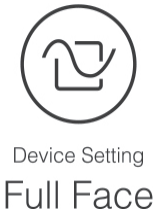  |
For AirSense, AirCurve or S9: Select ‘Full Face’.For other devices: Select ‘MIR FULL’ (if available), otherwise select ‘FULL FACE’ as the mask option. |
Notes:
- This product is not made with PVC or phthalates such as DEHP, DBP or BBP.
- This product is not made with natural rubber latex.
- The manufacturer reserves the right to change these specifications without notice.
StorageEnsure that the mask is thoroughly clean and dry before storing it for any length of time. Store the mask in a dry place out of direct sunlight.
DisposalThis mask does not contain any hazardous substances and may be disposed of with your normal household refuse.
Symbols
The following symbols may appear on your product or packaging:
  |
Catalog number |   |
Batch code |
  |
Humidity limitation |   |
Temperature limitation |
  |
Fragile, handle with care |   |
Not made with natural rubber
latex |
  |
Manufacturer |   |
European Authorized
Representative |
  |
Keep away from rain |   |
This way up |
  |
Full face mask |   |
Device setting – Full Face |
  |
Size – small |   |
Size – medium |
  |
Size – large | ||
   |
Indicates a Warning or Caution and alerts you to a possible injury or explains special measures for the safe and effective use of the device | ||
   |
Caution, consult accompanying documents | ||
  |
Prescription-only (In the US, Federal law restricts these devices to sale by or on the order of a physician) |
Limited warrantyResMed Pty Ltd (ResMed) warrants that your ResMed mask system (including mask frame, cushion, headgear and tubing) will be free from defects in material and workmanship from the date of purchase for 90 days, or in the case of disposable masks and disposable mask components for 7 days. This warranty is only available to the initial consumer. It is not transferable. If the product fails under conditions of normal use, ResMed will repair or replace, at its option, the defective product or any of its components. This limited warranty does not cover: a) any damage caused as a result of improper use, abuse, modification oralteration of the product; b) repairs carried out by any service organization that has not been expressly authorized by ResMed to perform such repairs; and c) any damage or contamination due to cigarette, pipe, cigar or other smoke. Warranty is void on products sold, or resold, outside the region of original purchase.Warranty claims on defective products must be made by the initial consumer at the point of purchase.This warranty replaces all other expressed or implied warranties, including any implied warranty of merchantability or fitness for a particular purpose.Some regions or states do not allow limitations on how long an implied warranty lasts, so the above limitation may not apply to you. ResMed will not be responsible for any incidental or consequential damages claimed to have resulted from the sale, installation or use of any ResMed product. Some regions or states do not allow the exclusion or limitation of incidental or consequential damages, so the above limitation may not apply to you. This warranty gives you specific legal rights, and you may also have other rights which vary from region to region. For further information on your warranty rights, contact your local ResMeddealer or ResMed office.
| A | Elbow |
| 1 | Valve (AAV) |
| 2 | Vent |
| 3 | Side buttons |
| 4 | Swivel |
| B | Frame |
| C | Cushion |
| D | Headgear |
| 5 | Magnetic clips |
| 6 | Lower headgear straps |
| 7 | Upper headgear straps |
| A+B+C | Frame system |
| A+B+C+D | Complete system |
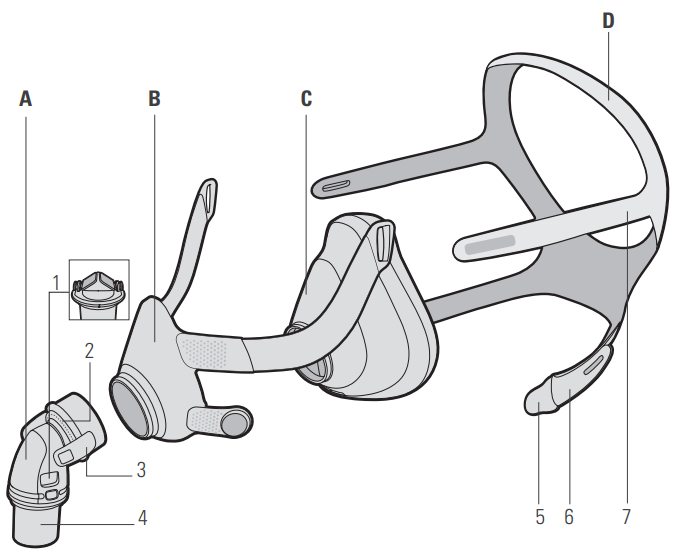

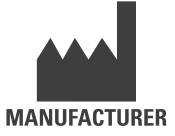

See ResMed.com for other ResMed locations worldwide. AirFit, AirSense and AirCurve are trademarks and/or registered trademarks of the ResMed family of companies. For patent and other intellectual property information, see ResMed.com/ip. © 2020 ResMed. 638238/2 2020-12
References
ResMed.com/downloads/masks
Resmed Product Support
Legal disclaimers and intellectual property – ResMed
Sleep apnea and COPD – learn about symptoms and treatment | ResMed
Legal disclaimers and intellectual property – ResMed
Resmed Product Support
Sleep apnea and COPD – learn about symptoms and treatment | ResMed
[xyz-ips snippet=”download-snippet”]

